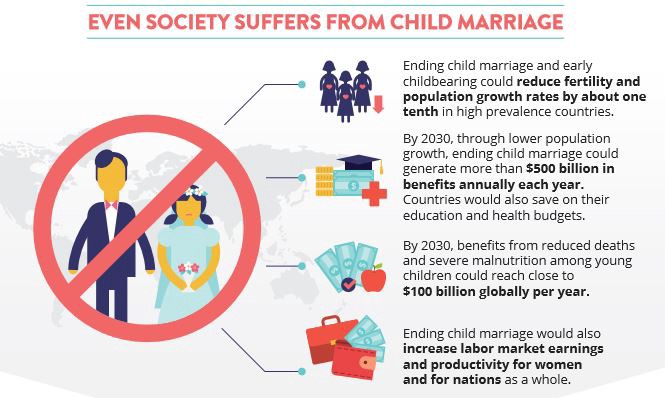NORMS AFFECTING THE HEALTH IMPACTS OF CHILD MARRIAGE ON WOMEN AND THEIR CHILDREN
Relevance:
Sociology: Gender, Emerging issues: ageing, sex ratios, child and infant mortality, reproductive health. & Violence against Women
G.S paper I: Society and social issues
Context
- The literature which treats child marriage as a risk factor for poor health outcomes in married girls and their babies provides an essential empirical basis to motivate action against child marriage, while simultaneously highlighting, often by its omissions, crucial gaps in our understanding of the normative context in which those poor health outcomes arise.

- A significant public health literature documents the impacts of child marriage on girls and women married as children, and many durable findings have emerged, such as the global association between higher rates of girl child marriage and higher rates of maternal and infant mortality (Raj and Boehmer, 2013).
- This work mainly focuses on sexual and reproductive health outcomes associated with early initiation of sexual activity and early pregnancy, and often treats child marriage as a risk factor for those outcomes.
- There is growing appreciation of the psychosocial impact of child marriage and how this plays out in their physical and mental health.
- Girls’ lack of mobility, social isolation, and inability to make decisions and their domestic roles contribute to their poor health.
- Empirical work has shown demographic consequences of child marriage including higher overall fertility, closer birth spacing, and less control by women of family planning and contraceptive use, and health impacts of early childbearing include higher risk of maternal mortality, fistula and undernourishment (Marphatia et al., 2017).
- In some cases, public health researchers add analyses which aim to tease out contextual factors.
- For example, a study showing the increased risk of maternal mortality for child brides also showed that countries with higher rates of girl child marriage also had higher non-utilisation of maternal health services, making a key link between the social and behavioural context of child marriage and the health outcomes associated with it (Raj and Boehmer, 2013).
- The identification of relevant structural factors like this can add to our understanding of how and why child marriage confers harm, and of what measures can mitigate that harm.
- A 2013 study in Ethiopia which found higher rates of suicidality in adolescent girls who were married, promised or had received marriage requests, added a layer of analysis that showed that girls living in communities actively working to stop child marriage experienced some protection from this association (risk of suicidal ideation) (Gage, 2013).
- This finding provided a basis for recommending stronger community engagement in child marriage prevention, and contributes to what we know about how to chip away at harmful normative structures.
- A recent review article of the health and social impacts of child marriage in Asia illustrated that marriage age is not only a ‘gateway’ to the many negative health consequences of early childbearing, as the public health world sees it, nor is it just a practice with human capital consequences, as social scientists may see it; rather, these issues are interconnected and mutually reinforcing (Marphatia et al., 2017).
- Similarly, studies have shown that children born to married girls are at higher risk of stunting (Efevbera et al., 2017), pre-term birth and low birth weight (Kurth et al., 2010) and infant mortality (Raj and Boehmer, 2013).
- Adolescent motherhood is often the true risk factor of interest in these studies rather than child marriage itself.
- These studies make an important empirical contribution by providing rigorous evidence of the intergenerational health harms of child marriage; however, they often miss the opportunity to engage with the contextual factors and social norms which drive child marriage and its associated outcomes.
- Often, researchers conclude that more research is needed on exactly how the associations they have documented happen.
- For example, a 2010 study finding that the risk of malnutrition is higher in young children born to mothers married as girls rightly calls for further research into how early marriage impacts children’s access to food (Raj et al., 2009).

